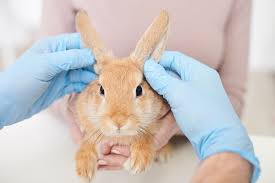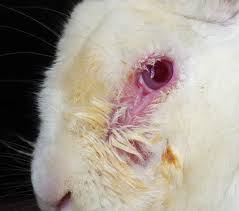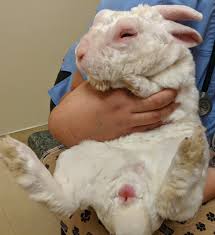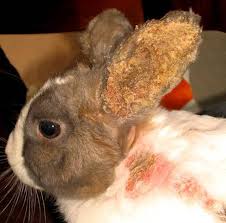A healthy rabbit can become diseased if exposed to stress or disease-causing organisms. It is the responsibility of the rabbit keeper to ensure that the rabbit remains healthy, unstressed, and in an environment where disease organisms are minimized.
A. Signs of a Healthy Rabbit
To identify a diseased rabbit, it is essential to know the signs of a healthy rabbit, which include:
- Normal eating and drinking
- Self-grooming
- Alertness, interest, and curiosity
- Shiny, smooth, and lean fur, particularly on the front paws and around the anus
- A normal temperature of 37ºC–39.5ºC
- Normal, silent breathing at 40–65 breaths per minute
- Clear, bright eyes without discharge
- Clear nostrils without discharge
- Normal caecotrophy, with no soft faeces on the hutch floor
- Gaining weight or, if an adult, maintaining its weight
Read Also: Seasonal and Daily Management Practices for Snail
B. Conditions That Make a Rabbit Susceptible to Disease

Rabbits may become more susceptible to diseases due to several conditions, including:
- Insufficient water
- Insufficient food
- Toxic or poisonous food
- An unbalanced diet lacking in energy, protein, minerals, or vitamins
- High-fiber-only foods that can cause bloating
- Sour or dirty foods that lead to diarrhea
- Dirty or poorly ventilated hutches that encourage the growth of disease-causing organisms
C. Preventive Measures for Common Rabbit Diseases
Cleanliness is crucial in rabbit care. Waterers and feeders should be washed and dried in the sun every few days. Cages should be disinfected when empty, and any sick animals should be separated from healthy ones.
D. Common Rabbit Diseases

1. Internal Parasites: Coccidiosis
Coccidiosis is caused by a protozoan called coccidia, which affects both the liver and intestines. It often occurs in overcrowded and dirty conditions. Affected rabbits may have a swollen stomach, diarrhea, dehydration, loss of appetite, and dullness.
Coccidia are commonly present in the intestines without obvious effects, but stress, such as weaning or poor weather, can cause them to multiply rapidly, leading to diarrhea.
This can soil the fur around the anus, and if untreated, flies may lay eggs in the matted fur, causing maggots that can lead to death. Young rabbits are particularly vulnerable just after weaning. In older rabbits, chronic coccidiosis can result in dullness and poor growth.
Control: Coccidiostats can be added to drinking water to prevent or treat coccidiosis. Keeping the hutch clean is an important preventive measure. Contamination of feed and water should be avoided.
2. External Parasites: Ear Mange and Skin Mange
Ear mange is caused by mites and leads to various skin and ear conditions. In ear mange, the entire ear may become filled with crusty scabs, and if untreated, the condition may spread to the face. Rabbits with ear mange may frequently shake their heads.
Control: Treatment involves using acaricide drops or creams, although these can be expensive. In many cases, a daily application of lightly powdered flowers of sulfur can be effective. Body mange can be treated by dipping the rabbit in an appropriate acaricide solution as recommended by a veterinarian.
Read Also: Best Snail Rearing Stocking Density for Best Results
E. Other Common Rabbit Diseases

1. Snuffles
Snuffles is a bacterial infection of the respiratory system, similar to a cold in humans. Outbreaks are more common in overcrowded conditions with poor ventilation and ammonia buildup from accumulated urine. Symptoms include sneezing, noisy breathing, a runny nose, and wet fur on the face and front legs from the rabbit wiping its nose.
Control: Affected rabbits should be isolated. While antibiotics may seem effective, mortality rates are often high, and recovered rabbits may be affected again if exposed to new stress.
2. Myxomatosis
Myxomatosis is a viral infection characterized by swelling of the eyes and convulsions. The disease spreads rapidly, typically carried by fleas. There is no treatment, and mortality is very high. Vaccination against myxomatosis is possible if the disease is reported in the area.
3. Dental Malocclusion (Buck Teeth)
Dental malocclusion, which can be inherited or caused by injury, is non-infectious. If hereditary, it can be prevented by culling affected lines and breeds. This condition causes inappropriate growth of the teeth, with the upper incisors growing too long and curling back, while the lower incisors protrude.
Control: Proper management and breeding can help prevent this issue.
4. Sore Hock
Sore hock is non-infectious and caused by rabbits walking on rough floors or sharp objects. The condition leads to sores on the hock, and if not treated, the foot may bleed or become infected.
Control: Soak the affected area in warm, soapy water to remove crusts, then dry it and apply ointment such as zinc ointment, carbolated vaseline, or sulphanamide powder.
5. Ear Canker
Ear canker is caused by parasitic mites, such as Psoroptes communis var cuniculi or Chorioptes cuniculi, which burrow under the skin and irritate the ear. Symptoms include excess moisture and crusting inside the ear, and the rabbit may frequently shake its head. If untreated, the condition can lead to wry neck, causing the rabbit to tilt its head or lose balance.
Control: Treatment involves using acaricides to eliminate the mites.
6. Pneumonia
Pneumonia is a bacterial infection caused by damp, unsanitary hutches without proper bedding. Affected rabbits may refuse to eat and develop elevated temperatures.
Control: Treatment with antibiotics like oxytetracycline or penicillin can be effective.
7. Conjunctivitis (Weepy Eyes)
Conjunctivitis is a bacterial disease that causes the rabbit to rub its eyes with its front feet, and a discharge is often present.
Control: Ophthalmic ointments containing sulphanamide or antibiotics can be used for treatment.
Rabbits are susceptible to a variety of bacterial, viral, and parasitic diseases. It is the responsibility of the rabbit keeper to maintain a healthy environment and minimize stress, thereby reducing the chances of disease occurrence.
Regular care, cleanliness, and proper management are key to keeping rabbits healthy and disease-free.
Do you have any questions, suggestions, or contributions? If so, please feel free to use the comment box below to share your thoughts. We also encourage you to kindly share this information with others who might benefit from it. Since we can’t reach everyone at once, we truly appreciate your help in spreading the word. Thank you so much for your support and for sharing!

